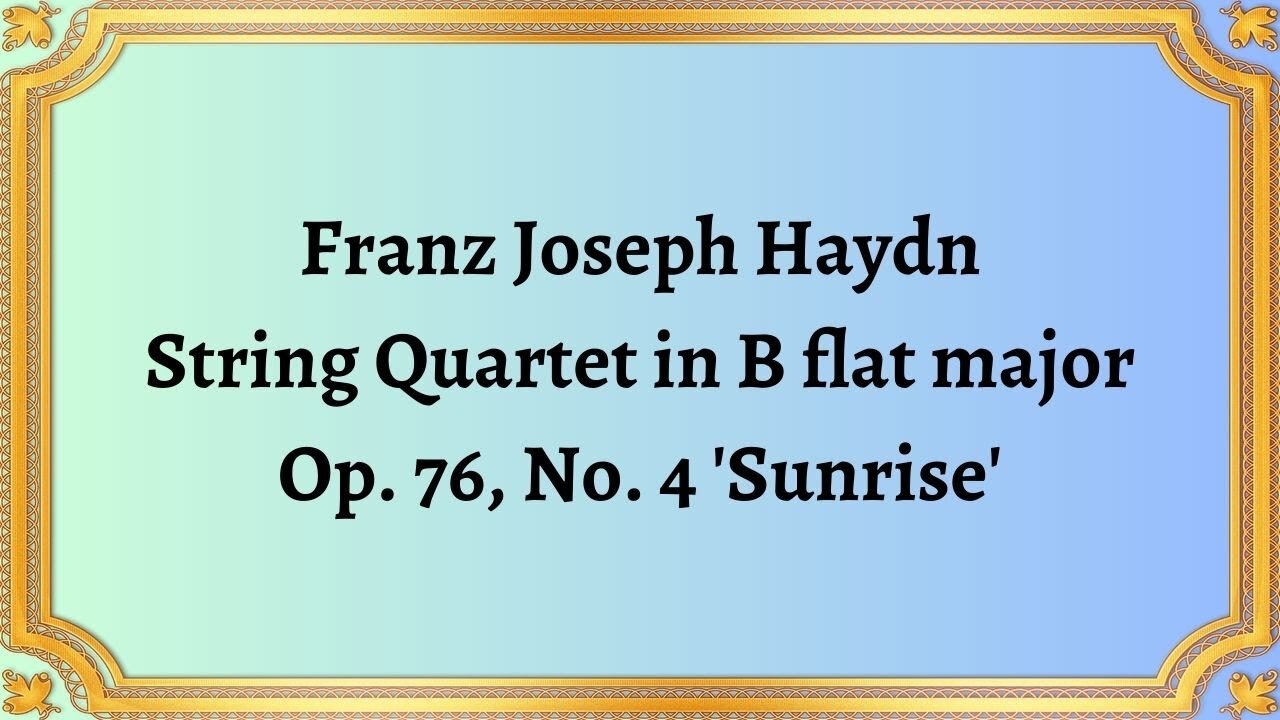Premium Only Content

Franz Joseph Haydn String Quartet in B flat major, Op. 76, No. 4 'Sunrise'"
#FranzJosephHaydn #StringQuartet #Bflatmajor #Op76No4 #Sunrise #ClassicalPeriod #ChamberMusic #InstrumentalTechnique #HarmonicSophistication #TonalColor #DynamicContrasts #MusicalBrilliance #Composition #MusicalForm #Musicality #ClassicalMusic #MusicHistory #OrchestralMusic #PerformingArts #MusicEducation #MusicAppreciation #Musicology #musicalgenius
Franz Joseph Haydn, one of the most prominent composers of the classical period, is known for his thousands of compositions ranging from operas and symphonies to concertos and quartets. Among his most celebrated quartets is the String Quartet in B-flat major, Op. 76, No. 4, nicknamed "Sunrise." This masterpiece, composed in 1797 near the end of his career, is a testament to Haydn's exceptional talent and musical brilliance.
The "Sunrise" quartet is one of a set of six quartets from Op. 76, Haydn's final collection of string quartets. Each of the six quartets has its nickname, with the fourth one, "Sunrise," getting its name from the gradual crescendo at the beginning of the first movement, which sounds like the gradual dawn of a new day.
The first movement, marked Allegro con spirito, is a dynamic and robust piece that features an ascending violin melody playing over a rhythmic background. It begins with a serene introduction by the cello and viola, and gradually builds up in intensity, similar to the sun rising. Throughout the movement, Haydn employs vivid contrasts, showcasing his command of tonal color and tension-release.
The second movement, marked Adagio, is serene, contemplative, and ethereal. It features a haunting melody played by the first violin, punctuated by the other instruments, imbuing the piece with a melancholic quality. The third movement, marked Menuetto, is a light and playful piece with bright and joyful melodies interweaving with rapid and contrasting rhythms.
The final movement, marked Allegro ma non troppo, is a lively and rhythmic piece full of surprises, changes of pace and dynamic contrasts. It has a jubilant and joyful character, like a celebration of the day's arrival.
What makes the "Sunrise" quartet stand out is its inventive use of harmony, counterpoint, and instrumental technique. Haydn makes subtle but effective changes to the instrumental parts throughout the quartet, keeping the listener engaged and challenged. He displays masterful control of form, launching the listener's imagination.
In conclusion, Franz Joseph Haydn's "Sunrise" String Quartet in B-flat major, Op. 76, No. 4 is a stunning piece of music that showcases the best of the composer's compositional abilities.
You have the opportunity to support the channel https://destream.net/live/RadSiarAl/donate
-
 2:13:07
2:13:07
vivafrei
5 hours agoEp. 243: HOLIDAY SPECIAL! The Great H1B Visa Debate! Jay z Gets Scorched! Attack in Germany! & MORE!
72.8K158 -
 16:40
16:40
Russell Brand
7 hours agoTHIS MASSIVELY BACKFIRED...
84.4K305 -
 25:41
25:41
SB Mowing
11 hours agoPICTURE living next to THIS and not knowing what to do…
33.8K22 -
 2:16:01
2:16:01
George Galloway
1 day agoNEW YEAR COUNTDOWN - MOATS with George Galloway - EP 408
54.6K115 -
 18:39
18:39
Stephen Gardner
7 hours ago🔥BREAKING! Trump's SHOCKING New Demand | Biden admits DOJ TARGETED Trump Illegally!
41.4K195 -
 1:20:23
1:20:23
Josh Pate's College Football Show
12 hours ago $11.57 earnedCFP Prediction Special: OhioSt vs Oregon | UGA vs Notre Dame | Texas vs ASU | Boise vs PennSt
79.1K6 -
 7:50:03
7:50:03
Scottish Viking Gaming
11 hours ago💚Rumble :|: SUNDAY FUNDAY :|: Virginia has two Verginers, Change my Mind!
96.1K18 -
 1:49:50
1:49:50
Winston Marshall
2 days agoThe DARK Reality of Socialism - Historian Giles Udy
76.3K83 -
 1:09:28
1:09:28
Sports Wars
9 hours agoBengals STAY ALIVE In OT Thriller, ESPN's Ryan Clark SLAMMED, NFL DESTROYS NBA On Christmas
62.7K7 -
 9:37
9:37
EvenOut
1 day ago $4.75 earnedThe Non-Reflecting Mirror Scare Twin Prank!
54.2K4